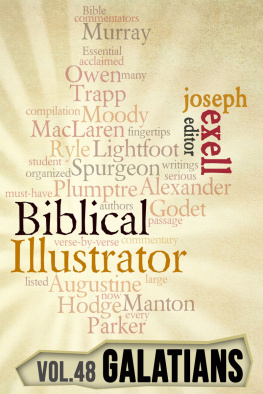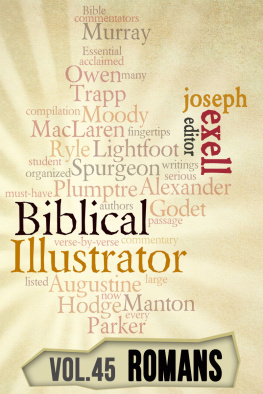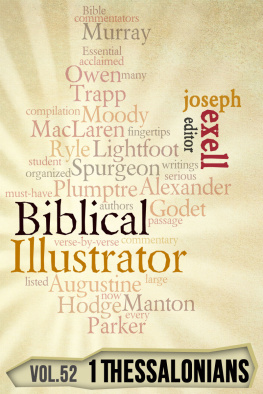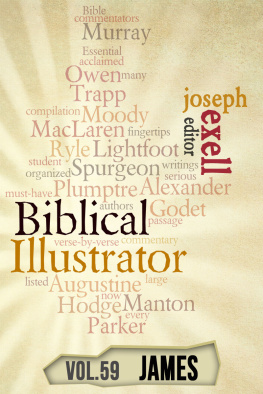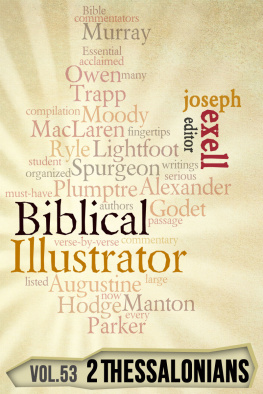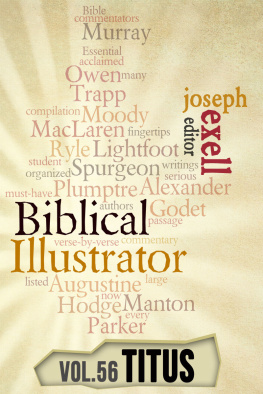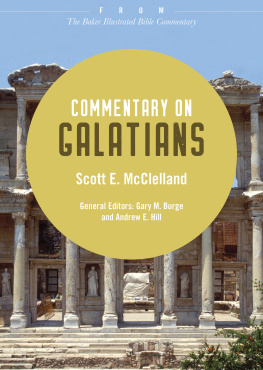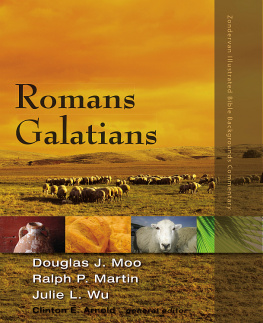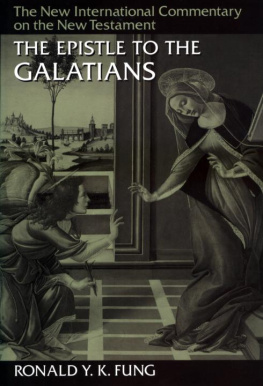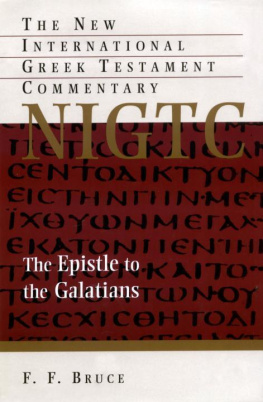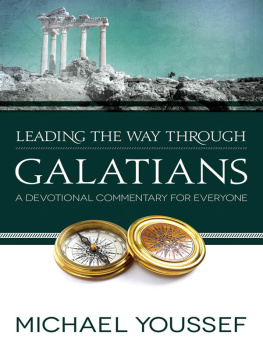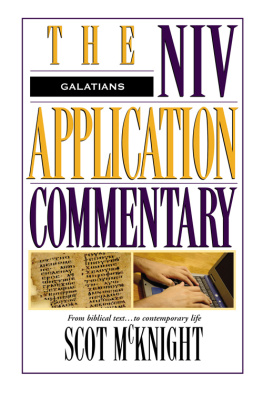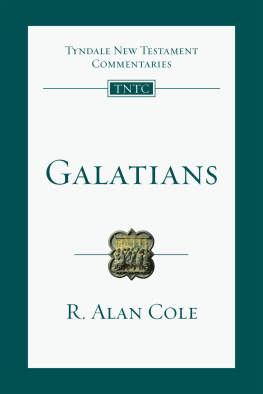Exell - The Biblical Illustrator - Galatians
Here you can read online Exell - The Biblical Illustrator - Galatians full text of the book (entire story) in english for free. Download pdf and epub, get meaning, cover and reviews about this ebook. year: 2012, genre: Religion. Description of the work, (preface) as well as reviews are available. Best literature library LitArk.com created for fans of good reading and offers a wide selection of genres:
Romance novel
Science fiction
Adventure
Detective
Science
History
Home and family
Prose
Art
Politics
Computer
Non-fiction
Religion
Business
Children
Humor
Choose a favorite category and find really read worthwhile books. Enjoy immersion in the world of imagination, feel the emotions of the characters or learn something new for yourself, make an fascinating discovery.
The Biblical Illustrator - Galatians: summary, description and annotation
We offer to read an annotation, description, summary or preface (depends on what the author of the book "The Biblical Illustrator - Galatians" wrote himself). If you haven't found the necessary information about the book — write in the comments, we will try to find it.
Exell: author's other books
Who wrote The Biblical Illustrator - Galatians? Find out the surname, the name of the author of the book and a list of all author's works by series.
The Biblical Illustrator - Galatians — read online for free the complete book (whole text) full work
Below is the text of the book, divided by pages. System saving the place of the last page read, allows you to conveniently read the book "The Biblical Illustrator - Galatians" online for free, without having to search again every time where you left off. Put a bookmark, and you can go to the page where you finished reading at any time.
Font size:
Interval:
Bookmark:
What if Charles Spurgeon helped you prepare next Sundays sermon?
Or what if you could talk over your preaching with Joseph Parker, Richard Baxter, Henry Ward Beecher and H. P. Liddon. Do you think it would make a difference to get the input of some of the greatest preachers who ever lived?
Thats precisely what Joseph Exell had in mind when he put together the massive series of volumes called The Biblical Illustrator. In what can only be called a Herculean feat, he spent years gathering preaching notes and sermon outlines from the very best preachers of his day (in the late 1800s and early 1900s), and he did it covering every book of the Bible.
Following the tradition of the time, he gave the series a flowery subtitle, describing it as anecdotes, similes, emblems, illustrations, expository, scientific, geographic, historical and homiletic, gathered from a wide range of home and foreign literature, on the verses of the Bible. He means that in these volumes you have everything you need in order to preach a sermon, teach a Bible class, or study a text on your own.
And it is amazingly comprehensive. Exell approached his task by taking every verse in the Bible and seeking to discover how it has been preached in the past. Though there is plenty of exegetical material here, this is not primarily a commentary.
This series is for preachers, teachers and Bible students.
Besides obviously being an omnivorous reader, he had a gift for amazing diligence. The Biblical Illustrator was published in 66 volumes. To give you a sense of how comprehensive it is, volume 49 contains 588 pages on Galatians. And the type in the original version was very small, with narrow margins so you almost had to have a magnifying glass to read it. But Joseph Exell had something in mind other than publishing a stylish book. He wanted to give preachers a book so complete that you could give it to someone and say, Go preach Galatians, and they could do it.
No one could ever use all the sermon outlines in the Biblical Illustrator. But thats not the point. We all agree that the best preacher starts with your study of the biblical text. But at some point you need to know what others have seen in the same text you are studying.
What did Spurgeon see?
What did Parker see?
What did Alexander MacLaren see?
Maybe you will see the same thing they did. Probably you will see something similar. But its entirely possible that Spurgeon (who has a flair for memorable phrasing) captured the thought of the text in a way that never occurred to you.
And there are times when the preacher needs some help in priming the pump. We all know what its like to be stuck in some passage of the Bible. You know what it says, you have studied the words, you have read a few commentaries, but somehow the message isnt jelling in your mind. Thats where the Biblical Illustrator is likely to be most helpful to you. If you are preaching on, say, Hebrews 10:19-25, you can find real help in the Biblical Illustrator. There is an expanded sermon outline by J. Colwell that almost anyone could expand into a profitable message. There is a lengthy and intricate outline by the Puritan pastor Thomas Boston and a moving exposition of Christ our high priest by Adolph Saphir.
Thats just one tiny example of one text. And Joseph Exell does that for every text in the Bible.
Its a phenomenal piece of work, and one that stands up very well more than a century later. I know of no comparable collection that has been done since then. I doubt if anyone would have the time or energy to attempt such a massive project today.
I bought my first copy of the Biblical Illustrator almost 20 years. Back then it came in six or seven massive volumes, printed on oversized pages with type so tiny I could hardly read it. About 10 years ago I purchased a CD with the Biblical Illustrator in PDF format. That was a huge improvement. But with the advent of ebook technology, we at last have the Biblical Illustrator in its most useful format. Because it is indexed to each section of the book, you can quickly find the passage you are looking for. And you can enlarge the text as much as you like.
As you can tell, Im big fan of the Biblical Illustrator because it preserves the wisdom of an earlier age. I would fully agree that you must start with your own study of the text, and we definitely need the fruit of recent biblical commentaries. But alongside your own study and the reading of current commentaries, there is a large place for reading the Biblical Illustrator.
Joseph Exell wanted to help preachers, teachers, and everyday Bible students. He succeeded admirably in his task. The fruit of his labors is now available for the first time in ebook format, making it more usable today than when it was first published.
For those who want to study the Bible and then teach it to others, the Biblical Illustrator will help you on every single text in the Bible. For over a century preachers and teachers have turned to it and found what they needed. I gladly say that it has often helped me, and I am glad to commend this series to you.
Dr. Ray Pritchard
President, Keep Believing Ministries
April 2012
Dallas, TX
The Galatian People. An Alien Race. W hen St. Paul carried the gospel into Galatia, he was thrown for the first time among an alien people differing widely in character and habits from the surrounding nations. A race, whose home was in the far west, they had been torn from their parent rock by some great social convulsion, and after drifting over wide tracts of country, had settled down at length on a strange soil in the very heart of Asia Minor. (Bishop Lightfoot)
Their History. The Galatians, in the strict sense, were the remains of a body of Gauls, who, after being repulsed in an attack on Delphi, B.C. 279, invaded Asia Minor. At first they carried all before them, but suffered a severe defeat from Attalus I. King of Pergamus, about B.C. 230, and were thus confined to the district which afterwards went by their name. Here they were conquered by the Romans under the Consul Manlius in 189, but allowed to retain their native princes until the death of Amyntas in B.C. 25, when Galatia was formally annexed to Rome. Shortly before the death of Amyntas, Galatia had been enlarged by extensive grants of territory in the south, and the greater part of this enlarged territory went to form the Roman province. (Professor Sanday.)
Their Nationality. It is commonly assumed that the Galatians were Celts. Some, however, have held them to be Germans. The arguments are
(1) Historical. All ancient writers speak of the Galatians as Celts; but Jerome, who knew both Gaul and Galatia well, says that their language was similar to that of the Treveri (modern Treves). I t is maintained that the Treveri were Germans. They seem, however, to have been originally Celts, but Germanized by a Frankish invasion,
(2) Philological. The preponderance of evidence here, too, is in favour of the Celtic origin of the Galatians. Of the three principal tribes into which the nation was divided, the Tectosages and Tolistobogii had counterparts in Gaul. The Trocmi are uncertain. The terminations of Galatian names are Celtic .... We may perhaps suppose that, though the main body of the people was Celtic, there were some few Germans mixed up with them. (Professor Sanday.)
Other Elements in their Population. Attention has hitherto been directed solely to the barbarian settlers. These, however, did not form by any means the whole population of the district. The Galatians whom Manlius subdued by the arms of Rome, and St. Paul by the sword of the Spirit, were a very mixed race. The substratum of society consisted of the original inhabitants of the invaded country, chiefly Phrygians, of whose language not much is known, but whose strongly-marked religious system has a prominent place in ancient history. The upper layer was composed of the Gaulish conquerors: while scattered irregularly through the social mass were Greek settlers, many of whom doubtless had followed the successors of Alexander thither and were already in the country when the Gauls took possession of it. To the country thus peopled the Romans, ignoring the old Phrygian population, gave the name of Gallograecia. At the time when Manlius invaded it, the victorious Gauls had not amalgamated with their Phrygian subjects, and the Roman consul on opening his campaign was met by a troop of the Phrygian priests of Cybele, who, clad in the robes of their order, and chanting a wild strain of prophecy, declared to him that the goddess approved of the war, and would make him master of the country. The great work of the Roman conquest was the fusion of the dominant with the conquered race the result chiefly, it would appear, of that natural process by which all minor distinctions are levelled in the presence of a superior power. From this time forward the amalgamation began, and it was not long before the Gauls adopted even the religion of their Phrygian subjects. But before St. Paul visited the country, two new elements had been added to this already heterogeneous population. The establishment of the province must have drawn thither a considerable number of Romans, not very widely spread in all probability, but gathered about the centres of government, either holding official positions themselves, or connected more or less with those who did .... A large influx of Jews must also have invaded Galatia. Antiochus the Great had settled two thousand Jewish families in Lydia and Phrygia, and even if we suppose that these settlements did not extend to Galatia properly so called, the Jewish colonists must in course of time have overflowed into a neighbouring country which possessed so many attractions for them. Those commercial instincts, which achieved a wide renown in the closely-allied Phoenician race, and which in the Jews themselves made rapid progress during the palmy days of their national life under Solomon, had begun to develop afresh. The innate energy of the race sought this new outlet, now that their national hopes were crushed, and their political existence was well nigh extinct. The country of Galatia afforded great facilities for commercial enterprise. With fertile plains rich in agricultural produce, with extensive pasture for flecks, with a temperate clime and copious rivers, it abounded in all those resources out of which a commerce is created. It was moreover conveniently situated for mercantile transactions, being traversed by a great highroad between the East and the shores of the Aegean, along which caravans were constantly passing, and among its towns it numbered not a few which are mentioned as great centres of commerce. We read especially of a considerable traffic in cloth goods, but whether these were of home or foreign manufacture we are not expressly told .... Still, with all this foreign admixture, it was the Celtic blood which gave its distinct colour to the Galatian character, and separated them by so broad a line even from their near neighbours. The tough vitality of the Celtic character maintained itself in Asia comparatively unimpaired among Phrygians and Greeks, as it has done in our own islands among Saxons, and Danes, and Normans, retaining its individuality of type after the lapse of ages and under conditions the most adverse. (Bishop Lightfoot)
Font size:
Interval:
Bookmark:
Similar books «The Biblical Illustrator - Galatians»
Look at similar books to The Biblical Illustrator - Galatians. We have selected literature similar in name and meaning in the hope of providing readers with more options to find new, interesting, not yet read works.
Discussion, reviews of the book The Biblical Illustrator - Galatians and just readers' own opinions. Leave your comments, write what you think about the work, its meaning or the main characters. Specify what exactly you liked and what you didn't like, and why you think so.

